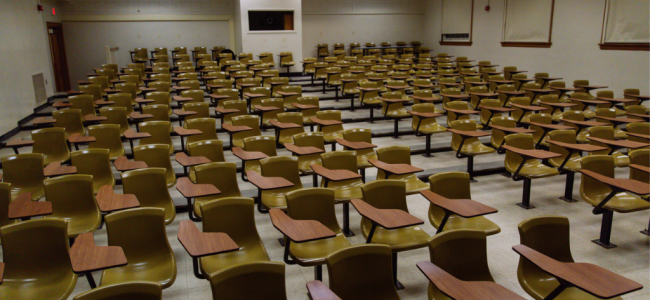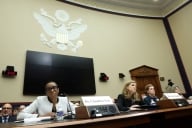You have /5 articles left.
Sign up for a free account or log in.

Istockphoto.com/Ryan Herron
Four-year colleges may face a loss of up to 20 percent in fall enrollment, SimpsonScarborough, a higher education research and marketing company, has predicted on the basis of multiple student surveys it has conducted.
The findings are based on surveys of more than 2,000 college-bound high school seniors and current college students in March, just after the coronavirus began spreading in the United States, and in April, after three weeks of record unemployment claims.
The finding are based on several surveys, one of which was released previously.
- Ten percent of college-bound seniors who had planned to enroll at a four-year college before the COVID-19 outbreak have already made alternative plans.
- Fourteen percent of college students said they were unlikely to return to their current college or university in the fall, or it was "too soon to tell." Exactly three weeks later, in mid-April, that figure had gone up to 26 percent.
- Gap years may be gaining in popularity. While hard to track, there are estimates that 3 percent of freshmen take a gap year. Since the pandemic, internet searches for gap years have skyrocketed.
- College students do not like the online education they have been receiving. To finish their degrees, 85 percent want to go back to campus, but 15 percent want to finish online.
The numbers are particularly bleak for minority students.
Forty-one percent of minority high school seniors say it's likely they won't go to college at all in the fall or "it's too soon to say." That compares to 24 percent of white high school seniors. With deadlines looming (some colleges expect answers to admissions offer by May 1, although many have delayed the date), 24 percent of minority students say they haven't decided which college to attend. The number for white students is 14 percent. Because of COVID-19, the top choice of college has changed for a third of undecided minority students but only 15 percent of undecided white students.
Minority students who are in college are also feeling the impact of COVID-19 and related matters more than white students. Thirty-two percent of minority students and 22 percent of white college students said it was unlikely they will return to their college this fall or "it's too soon to say." Nearly two-thirds of minority students (64 percent) said their plans were being affected by COVID-19, compared to 44 percent of white students.
Some colleges will fare better, the SimpsonScarborough report says, based on prestige or location or particularly sensitive administrators. But as a whole, "the effect on higher education enrollment could be catastrophic."
Elizabeth Johnson, chairman of SimpsonScarborough, said, "We felt after our first survey that we couldn't make predictions," because COVID-19 had just spread in the U.S. and most students and more colleges weren't prepared for it. But having surveyed again, after a full month with COVID-19, the results were mostly the same or (from colleges' perspective) worse.
By combining the various factors, she said she came up with the 20 percent figure for decreased enrollment. Obviously, there is a giant what-if to consider. But most of the what-ifs that colleges hope for -- what if a vaccine were developed -- aren't going to happen by the fall, she said.
She strongly advised colleges to start talking with their students about the various scenarios they face. She noted the blog post "15 Fall Scenarios," which Inside Higher Ed recently published, by bloggers Joshua Kim of Dartmouth College and Edward J. Maloney of Georgetown University. Colleges should try to figure out which of those scenarios they are embracing and talk to students, she said. (She will discuss the findings at a webcast today at 1 p.m. Eastern. Sign up here.)
SimpsonScarborough's is not the only recent survey. And the other surveys, while some take different approaches, have the same overall tone.
Tyton Partners recently surveyed parents and found many of them are dubious of paying full tuition rates for a continuation of online education in the fall.
Lipman Hearne on Tuesday released a new survey of parents of high school seniors, conducted in March and in April. Lipman Hearne found that the April parents were more likely to want their children to go to college close to home (52 percent versus 45 percent). And it found that 56 percent of parents were interested in a delayed January start, and 46 percent said they wanted their child to start at a less expensive institution and then transfer. And 61 percent believe online instruction of the sort started by colleges this spring will reduce the quality of higher education.
Art & Science Group polled 1,171 high school seniors from April 21-24 and found that one in six students who'd planned to attend four-year colleges full-time no longer plan to do so.
Richard Hesel, a principal with the group, said further numbers showed that 60 percent of students have no interest in online education. And two-thirds of students think they should pay "much less" for tuition if the programs they have been shifted to in recent weeks should continue in the next academic year.
David Hawkins, executive director for educational content and policy at the National Association for College Admission Counseling, said such surveys serve a valuable purpose.
"At a time when information is at a premium, surveys like this can be useful in helping colleges plan for an uncertain future," he said. "Of course, survey research has limitations, in that it tends to rely on a snapshot in time, so responses today might change substantially based on new information or events in the future. Colleges will have to conduct outreach to their own population of students to assess the pandemic’s impact on fall enrollment, as changes are bound to vary by institution. But as a general indicator that times will be difficult moving forward, these surveys are sending a message to colleges and to policy makers that this crisis might put college out of reach for a large number of students."
What is he looking for? "Over all, the primary effect we’re considering, both for students and institutions, is financial. The COVID-19 outbreak seems likely to result in an economic downturn that rivals or outpaces the 2008 recession, absent a significant infusion of public assistance from state and federal governments. That will affect students’ ability to enroll and colleges’ ability to maintain services for students."








